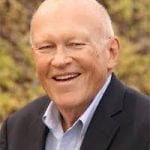
Simon Sinek

Ken Blanchard
I recently watched a video of Ken Blanchard and Simon Sinek on stage together talking about leadership. They were primarily answering questions from the local audience and I thought there were a few gems in their answers. For those not familiar with these two gentlemen:
- Ken Blanchard, now aged 80 is an American writer and consultant on leadership and management who has authored or co-authored 60 books. His most famous is the One Minute Manager. He is also the co author of the Situational Leadership model which is widely used.
- Simon Sinek, aged 46 is a British-American author and motivational speaker, best known for this book Start with Why and a TED talk of the same name. He is pretty hot right now and in great demand as a speaker and consultant.
Ken and Simon had never been on the same stage before but noted that they share a vision that the vast majority of people wake up every morning inspired, feel safe when at work and return home fulfilled at the end of the day.
Customers or employees first?
There was complete agreement from them on this one and these five statements are pure gold:
- The best organisations treat employees as the best customer
- Engaged people looking after customers and create raving fans
- Profit is the applause you get for creating a motivating environment for your people
- Customers will never love the company until employees love it first
- You want frontline employees obsessed with taking care of each other and taking care of the customer, but they have to feel taken care of first
Tackling a lack of employee engagement
Asked on how to tackle this Ken and Simon said:
- We have a leadership crisis
- We don’t view jobs as long term – people don’t show loyalty because the company doesn’t show loyalty to them and we don’t have a “safe” environment inside companies
- We should take the view that Garry Ridge the president of WD40 takes and that is that we don’t have mistakes we only have learning opportunities
- Garry also make sure that every time a new leader is appointed at WD40 that leader is trained to be a coach
(Garry Ridge is an Australian who was running the local operations of WD-40 in the 80‘s before shifting to the USA and ultimately assuming the top job.)
Practical things to build “safety”
- Build learning opportunities
- As a leader listen more than you talk
- Wander around and catch people doing things right and accent the positive
- Leadership is a teachable, learnable skill but we don’t teach leaders how to lead
- A simple idea to apply – have a book club, read a chapter each week or month and discuss it or discuss a TED talk
- Research shows the person who is the best at doing a task is generally not the best person to lead or coach the team doing that task
What future shifts in the working world should we prepare for
- Prepare for shift all the time
- Manage the present and create the future
- Technically the CEO is the president of the future and the COO or CFO the president of the present
- Simon sees the CEO is the chief vision officer
- Get rid of normalised curves – this is a reference to a way to manage employee performance which long time GE leader Jack Welch popularised and which basically involves getting rid of your bottom 10% ranked employees on a regular cycle
- Your responsibility is to help people get an A – not to be in the bottom 10%
What do first time managers need to know ?
- No one comes to work to be managed but we all like to be led
- Your job changes when you become a manager – it’s about the people
- Some skills to learn include active listening, giving and receiving feedback, patience and empathy
- As a manager understand you are responsible for the wellbeing of your people
- Turn the pyramid upside down and support your people
- Don’t forget to share vision and goals as people need to know where they are going
I’m not suggesting you watch the video but I think there is some gold in these comments above for every manager and leader to consider. As accounting firm leaders and managers I encourage you to apply with enthusiasm and commitment some of the ideas shared by Ken and Simon.
